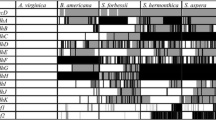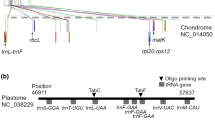Abstract
The plastid genome sequence of the parasitic liverwort Aneura mirabilis revealed the loss of five chlororespiration (ndh) genes. Additionally, six ndh genes, subunits of photosystem I, photosystem II, and the cytochrome b6f complex were inferred to be pseudogenes. Pseudogenes of cysA, cyst, ccsA, and ycf3, an inversion of psbE and petL, were also detected. The designation of pseudogenes was made using comparisons with the distantly related liverwort Marchantia polymorpha. We sampled several populations of A. mirabilis and its photosynthetic sister groups to correlate functional gene losses with the evolution of a achlorophylly. The gene losses, pseudogenes, or the psbE-petL inversion were never detected in a photosynthetic Aneura but were detected in every population of A. mirabilis. One population of A. mirabilis revealed a unique deletion of 541 bp in the psbE-petL region; another is characterized by a unique deletion of 471 bp in the trnV(UAC)-ndhC region. The ratio of synonymous-to-nonsynonymous substitution rates (ω) was estimated for eight pseudogenes and six ORFs to detect relaxed purifying selection. A significant increase in ω for the nonphotosynthetic liverwort was detected in six pseudogenes. Relaxation purifying selection, determined by a significant increase in ω, was detected for three intact ORFs: psbA, psbM, and rbcL.



Similar content being viewed by others
References
Allison LA, Simon LD, Maliga P (1996) Deletion of rpoB reveals a second distinct transcription system in plastids of higher plants. EMBO J 15:2802–2809
Berg S, Krupinska K, Krause K (2003) Plastids of three Cuscuta species differing in plastid coding capacity have a common parasite-specific RNA composition. Planta 218:135–142
Bidartondo MI (2005) The evolutionary ecology of myco-heterotrophy. New Phytol 167:335–352
Bidartondo MI, Bruns TD, Weiss M, Sergio C, Read DJ (2003) Specialized cheating of the ectomycorrhizal symbiosis by an epiparasitic liverwort. Proc R Soc Lond B Biol Sci 270:835–842
Brundrett MC (2002) Coevolution of roots and mycorrhizas of land plants. New Phytol 154:275–304
Bungard RA (2004) Photosynthetic evolution in parasitic plants: insight from the chloroplast genome. BioEssays 26:235–247
Cox CJ, Goffinet B, Shaw AJ, Boles SB (2004) Phylogenetic relationships among the mosses based on heterogeneous Bayesian analysis of multiple genes from multiple genomic compartments. Syst Bot 29:234–250
Crandall-Stotler B, Stotler RE (2000) Morphology and classification of Marchantiophyta. Cambridge University Press, Cambridge
Davis EC (2004) A molecular phylogeny of leafy liverworts (Jungermanniidae: Marchantiophyta). Missouri Botanical Garden Press, St. Louis
Delavault P, Thalouarn P (2002) The obligate root parasite Orobanche cumana exhibits several rbcL sequences. Gene 297:85–92
Delavault PM, Russo NM, Lusson NA, Thalouarn PA (1996) Organization of the reduced plastid genome of Lathraea clandestina, an achlorophyllous parasitic plant. Physiol Plantarum 96:674–682
dePamphilis CW, Palmer JD (1990) Loss of photosynthetic and chlororespiratory genes from the plastid genome of a parasitic flowering plant. Nature 348:337–339
Feild TS, Brodribb TJ (2005) A unique mode of parasitism in the conifer coral tree Parasitaxus ustus (Podocarpaceae). Plant Cell Environ 28:1316–1325
Forrest LL, Davis EC, Long DG, Crandall-Stotler BJ, Clark A, Hollingsworth ML (2006) Unraveling the evolutionary history of the liverworts (Marchantiophyta): multiple taxa, genomes and analyses. Bryologist 109:303–334
Funk HT, Berg S, Krupinska K, Maier UG, Krause K (2007) Complete DNA sequences of the plastid genomes of two parasitic flowering plant species, Cuscuta reflexa and Cuscuta gronovii. BMC Plant Biol 7:45
Goffinet B, Bayer RJ, Vitt DH (1998) Circumscription and phylogeny of the Orthotrichales (Bryopsida) inferred from rbcL sequence analyses. Am J Bot 85:1324–1337
Goffinet B, Wickett NJ, Shaw AJ, Cox CJ (2005) Phylogenetic significance of the rpoA loss in the chloroplast genome of mosses. Taxon 54:353–360
Haberhausen G, Zetsche K (1994) Functional loss of all ndh genes in an otherwise relatively unaltered plastid genome of the holoparasitic flowering plant Cuscuta reflexa. Plant Mol Biol 24:217–222
Hager M, Hermann M, Biehler A, Krieger-Liszkay A, Bock R (2002) Lack of the small plastid-encoded psbJ polypeptide results in a defective water-splitting apparatus of photosystem II, reduced photosystem I levels, and hypersensitivity to light. J Biol Chem 277:14031–14039
Hajdukiewicz PTJ, Allison LA, Maliga P (1997) The two RNA polymerases encoded by the nuclear and the plastid compartments transcribe distinct groups of genes in tobacco plastids. EMBO J 16:4041–4048
Hillis DM, Bull JJ (1993) An empirical test of bootstrapping as a method for assessing confidence in phylogenetic analysis. Syst Biol 42:182–192
Kellogg EA, Juliano ND (1997) The structure and function of RuBisCO and their implications for systematic studies. Am J Bot 84:413–428
Korall P, Pryer KA, Metzgar JS, Schneider H, Conant DS (2006) Tree ferns: monophyletic groups and their relationships as revealed by four protein-coding plastid loci. Mol Phylogenet Evol 39:830–845
Kosakovsky Pond SL, Frost SDW (2005) A genetic algorithm approach to detecting lineage-specific variation in selection pressure. Mol Biol Evol 22:478–485
Kosakovsky Pond SL, Frost SDW, Muse SV (2005) HyPhy: hypothesis testing using phylogenies. Bioinformatics 21:676–679
Krause K, Berg S, Krupinska K (2003) Plastid transcription in the holoparasitic plant genus Cuscuta: parallel loss of the rrn16 PEP-promoter and of the rpoA and rpoB genes coding for the plastid-encoded RNA polymerase. Planta 216:815–823
Krause K, Maier RM, Kofer W, Krupinska K, Herrmann RG (2000) Disruption of plastid-encoded RNA polymerase genes in tobacco: expression of only a distinct set of genes is not based on selective transcription of the plastid chromosome. Mol Gen Genet 263:1022–1030
Kuijt J (1969) The biology of parasitic flowering plants. University of California Press, Berkeley
Maddison DR, Maddison WP (2000) MacClade version 4: analysis of phylogeny and character evolution. Sinauer Associates, Sunderland, MA
McNeal J, Kuehl J, Boore J, de Pamphilis C (2007) Complete plastid genome sequences suggest strong selection for retention of photosynthetic genes in the parasitic plant genus Cuscuta. BMC Plant Biol 7:57
Melis A, Chen HC (2005) Chloroplast sulfate transport in green algae—genes, proteins and effects. Photosynth Res 86:299–307
Nickrent DL, Yan OY, Duff RJ, dePamphilis CW (1997) Do nonasterid holoparasitic flowering plants have plastid genomes? Plant Mol Biol 34:717–729
Nickrent DL, Duff RJ ECA, Wolfe AD, Young ND, Steiner KE, dePamphilis CW (1998) Molecular phylogenetic and evolutionary studies of parasitic plants. Kluwer, Boston
Nylander JAA (2004) MrModeltest v2. Program distributed by the author, Evolutionary Biology Centre, Uppsala University
Ohta N, Galsworthy PR, Pardee AB (1971) Genetics of sulfate transport by Salmonella typhimurium. J Bacteriol 105:1053–1062
Ohyama K, Fukuzawa H, Kohchi T, Shirai H, Sano T, Sano S, Umesono K, Shiki Y, Takeuchi M, Chang Z, S-i Aota, Inokuchi H, Ozeki H (1986) Chloroplast gene organization deduced from complete sequence of liverwort Marchantia polymorpha chloroplast DNA. Nature 322:572–574
Perold SM (2001) Studies in the liverwort family Aneuraceae (Metzgeriales) from southern Africa. 1. The genus Aneura and its local representative. Bothalia 31:167–173
Qiu YL, Li LB, Wang B, Chen ZD, Knoop V, Groth-Malonek M, Dombrovska O, Lee J, Kent L, Rest J, Estabrook GF, Hendry TA, Taylor DW, Testa CM, Ambros M, Crandall-Stotler B, Duff RJ, Stech M, Frey W, Quandt D, Davis CC (2006) The deepest divergences in land plants inferred from phylogenomic evidence. Proc Natl Acad Sci USA 103:15511–15516
Quiles MJ (2006) Stimulation of chlororespiration by heat and high light intensity in oat plants. Plant Cell Environ 29:1463–1470
Rambaut A, Drummond AJ (2007) Tracer v1.4. Program distributed by the authors
Randle CP, Wolfe AD (2005) The evolution and expression of rbcL in holoparasitic sister-genera Harveya and Hyobanche (Orobanchaceae). Am J Bot 92:1575–1585
Read DJ, Duckett JG, Francis R, Ligrone R, Russell A (2000) Symbiotic fungal associations in ‘lower’ land plants. Phil Trans R Soc Lond B 355:815–830
Rochaix JD (2006) The role of nucleus- and chloroplast-encoded factors in the synthesis of the photosynthetic apparatus. Springer, Dordrecht
Rochaix JD, Perron K, Dauvillee D, Laroche F, Takahashi Y, Goldschmidt-Clermont M (2004) Post-transcriptional steps involved in the assembly of photosystem I in Chlamydomonas. Biochem Soc Trans 32:567–570
Ronquist F, Huelsenbeck JP (2003) MRBAYES 3: Bayesian phylogenetic inference under mixed models. Bioinformatics 19:1572–1574
Schuster RM (1992) The Hepaticae and Anthocerotae of North America, vol V. Field Museum of Natural History, Chicago, IL
Sirko A, Hryniewicz M, Hulanicka D, Bock A (1990) Sulfate and thiosulfate transport in Escherichia coli K-12: nucleotide sequence and expression of the cysTWAM gene cluster. J Bacteriol 172:3351–3357
Stoebe B, Martin W, Kowallik KV (1998) Distribution and nomenclature of protein-coding genes in 12 sequenced chloroplast genomes. Plant Mol Biol Rep 16:243–255
Sugiura C, Kobayashi Y, Aoki S, Sugita C, Sugita M (2003) Complete chloroplast DNA sequence of the moss Physcomitrella patens: evidence for the loss and relocation of rpoA from the chloroplast to the nucleus. Nucleic Acids Res 31:5324–5331
Swofford DL (2002) PAUP*: Phylogenetic Analyses Using Parsimony (*and other methods). Version 4. Sinauer, Sunderland, MA
Thalouarn P, Theodet C, Russo N, Delavault P (1994) The reduced plastid genome of a nonphotosynthetic angiosperm Orobanche Hederae has retained the rbcL gene. Plant Physiol Biochem 32:233–242
Tillich M, Lehwark P, Morton BR, Maier UG (2006) The evolution of chloroplast RNA editing. Mol Biol Evol 23:1912–1921
Wickett NJ, Goffinet B (2008) Origin and relationships of the myco-heterotrophic liverwort Cryptothallus mirabilis Malmb. (Metzgeriales, Marchantiophyta). Bot J Linn Soc 156:1–12
Wickett NJ, Zhang Y, Hansen SK, Roper JM, Kuehl JV, Plock SA, Wolf PG, dePamphilis CW, Boore JL, Goffinet B (2008) Functional gene losses occur with minimal size reduction in the plastid genome of the parasitic liverwort Aneura mirabilis. Mol Biol Evol 25:393–401
Wimpee CF, Wrobel RL, Garvin DK (1991) A divergent plastid genome in Conopholis americana, an achlorophyllous parasitic plant. Plant Mol Biol 17:161–166
Wolfe AD, dePamphilis CW (1997) Alternate paths of evolution for the photosynthetic gene rbcL in four nonphotosynthetic species of Orobanche. Plant Mol Biol 33:965–977
Wolfe AD, dePamphilis CW (1998) The effect of relaxed functional constraints on the photosynthetic gene rbcL in photosynthetic and nonphotosynthetic parasitic plants. Mol Biol Evol 15:1243–1258
Wolfe KH, Morden CW, Palmer JD (1992) Function and evolution of a minimal plastid genome from a nonphotosynthetic parasitic plant. Proc Natl Acad Sci USA 89:10648–10652
Young ND, dePamphilis CW (2005) Rate variation in parasitic plants: correlated and uncorrelated patterns among plastid genes of different function. BMC Evol Biol 5:16
Zwickl DJ (2006) Genetic algorithm approaches for the phylogenetic analysis of large biological sequence datasets under the maximum likelihood criterion. University of Texas at Austin, Austin
Acknowledgments
This study was supported by grants from the National Science Foundation (EF-0531557 to B.G. and doctoral dissertation improvement grant DEB-0408043 to N.W.), the National Geographic Society, Sigma Xi, and the University of Connecticut (an R. A. Bamford endowment to Ecology and Evolutionary Biology and a Doctoral Dissertation Fellowship). David Long assisted in obtaining fresh, field-collected material. Herbarium material or DNA was provided by Laura Forrest, Blanka Shaw, Nancy Slack, Alain Vanderpoorten, the New York Botanical Garden, and the Swedish Museum of Natural History. The authors thank Ned Young for assistance with HyPhy and thank Louise Lewis and Kent Holsinger for comments on an early version of the manuscript.
Author information
Authors and Affiliations
Corresponding author
Electronic Supplementary Material
Rights and permissions
About this article
Cite this article
Wickett, N.J., Fan, Y., Lewis, P.O. et al. Distribution and Evolution of Pseudogenes, Gene Losses, and a Gene Rearrangement in the Plastid Genome of the Nonphotosynthetic Liverwort, Aneura mirabilis (Metzgeriales, Jungermanniopsida). J Mol Evol 67, 111–122 (2008). https://doi.org/10.1007/s00239-008-9133-1
Received:
Revised:
Accepted:
Published:
Issue Date:
DOI: https://doi.org/10.1007/s00239-008-9133-1




